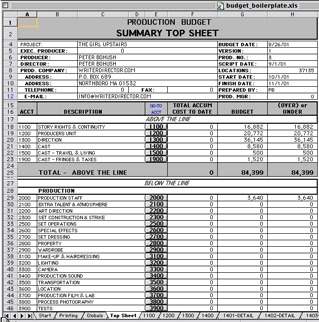
Easy Budget, BoilerPlate and Script Werx
Written by Peter Bohush | Posted by: Anonymous
A script exists only in the writer’s imagination until it is materialized as a series of ink splotches on paper. These dabbles evoking far away places and exciting actions are all happy and nice until someone presents another piece of paper with ink splotches on it — the budget.
Suddenly every exotic locale and blown up building, so great in the writer’s mind, become line items with dollar signs and lots of zeroes to the left of the decimal point. Cash money. Money somebody doesn’t have and isn’t going to give. Very quickly the script’s cast of thousands in the Gobi Desert becomes three day players in a parking lot in Cucamonga.
Drat that budget and the software it came in on! And curse that script software. Just because it can write EXT. TEEMING ALIEN METROPOLIS ABUZZ WITH FLYING SHIPS AND EXTRATERRESTRIALS does that mean someone should, just to get his or her money’s worth from the software?
There are several popular stand-alone products for film production budgeting and script writing. Most are full-featured, robust and relatively expensive. But alternatives to these products exist that piggyback onto other applications that the user may already own.
Easy Budget, BoilerPlate and Script Werx require Microsoft Office (or an equivalent spreadsheet application) to provide much of the functionality of stand-alone budgeting and script formatting software — for less cost. This is presuming the user would already have shelled out the $500 or more for Office and wants to leverage that investment.
Easy Budget
Easy Budget, from The Easy Budget Company, consists of two production budgeting templates for Microsoft Excel or an equivalent spreadsheet application. Each template is sold separately at $169.95 each; one is for feature films and the other for commercial shoots. The software runs on Windows or Macintosh and is sold only on 3.5" floppy diskettes.
Installation is quick and easy. The application itself sports a colorful and friendly interface that won’t scare off users who aren’t accountants or spreadsheet experts. There are 16 tabs along the bottom of the worksheet, each representing a different section of a production budget.
Users open each worksheet in the budget and tab through the fields, and enter names of production personnel, estimated work days and their rates, along with other information such as location fees, expendables, equipment rentals and, of course, all the producer’s expenses, such as his secretary, entertainment and travel. There’s also a field called Producer’s Flat Expense, which we presume means the costs associated his London apartment rental that he needs to use on his way to and from Cannes, right?
Global rates can also be added in the Specs section, along with taxes and fringe benefits required by unions. Rates such as the daily rate for extras or meal per diems will populate throughout the rest of the budget as necessary, so the happy budgeteer need only enter the number of people and days and watch as the budget magically balloons up to Pearl Harbor proportions.
Some of the budget sections in Easy Budget required you enter days worked but didn’t use this to calculate this person’s pay. Instead the user must enter the full production rate, which then is included into the overall budget. One could see this is lacking functionality.
Easy Budget will analyze some entries, such as SAG actors, and determine if it’s cheaper to pay them on a weekly rate or daily rate based on the number of days they are scheduled to work.
Easy Budget creates budgets in Excel 2001 and previous version formats — a useful feature if the budget needs to be shared with someone using an old version of Excel. It generally performed well, although once in awhile I encountered a few errors opening and saving files. And on one use, a new worksheet tab called Module 1 appeared. Being the stupidly curious type, I clicked it. In scriptwriter’s parlance, what happened next was "SFX: A blinding flash of light. Then silence. Eerie silence."
Now if I can just figure out how much that special effect will cost to get onscreen…
Easy Budget provides an industry Labor Rates database online to registered users to aid in calculating union rates for all the major job functions.
BoilerPlate
BoilerPlate ($149 via download only) from BBP Software is a film production budgeting software template for Microsoft Excel (Win/Mac) or Lotus 1-2-3. Their new version is designed for Excel 2000 on Windows 98/NT. I tested this on a Mac running Excel 2001 and found it to run fine with the exception of the printing macros. Printing via the Print command worked.
Give Excel a decent amount of memory and this template provides a tremendous amount of detail to create an accurate production budget. There are in the neighborhood of 70 worksheet tabs to fill in covering everything from hair spray to honey wagons.
The post-production sections are impressive and extensive. There’s at least one budget line for every person you see scroll by at the end of your favorite blockbuster. Now you’ll know why movies cost so much!
BoilerPlate provides quick links to jump to sections in the workbook. Euro currency is supported (a feature of Excel — I suppose you could also do a budget in Yen). And data can be imported from QuickBooks Pro.
There are also numerous contact lists for cast and crew, production rental, locations and props "databases" and a number of cash-flow reports. Users can unlock and modify the template to suit their needs.
I see no reason why this template wouldn’t fit the needs of small production houses, commercial shoots, documentaries, epic features and everything in between.
Script Werx
Script Werx ($129 Mac/Win) from Parnassus Software provides 12 templates for Microsoft Word that help writers create properly formatted screenplays, video and television scripts, storyboard documents, treatments and interview questionnaires.
Since it’s running in Word, Script Werx features the best and worst that Word has to offer. It adds functionality to Word to help a writer quickly format a script while writing it. Using the familiar tab/enter key combinations (although in reverse from the major stand-alone products), Script Werx helps writers turn Word into a powerhouse script formatter.
The keyboard commands have a small learning curve. Users of standalone products may find themselves hitting Enter and expecting to have an action line appear — in Script Werx it’s the Tab key, while Enter formats a character name or line of dialogue.
Users will have to do a bit more clicking with the mouse to get to some of the commands, such as to start a new scene. Numbering scenes is quick and easy, although it uses Word’s evil numbering feature and may be subject to problems if a user edits a script after it’s been scene-numbered.
Importing text or RTF encoded script files is a bit tricky, as the user must enter every single character’s name before the script will fully import. But that’s not a core feature of Script Werx, so it shouldn’t be judged on how poorly Word handles formatted text from other applications.
Script Werx has an impressive Storyboard command that reformats a script into a two-column document with storyboard squares next to scene headings and/or dialogue. And its dozen templates should suit any kind of visual production script need.
Many struggling screenwriters balk at paying $250 for one of the major script formatting programs that include production breakdown reports and other unneeded features. At half the price (plus the cost of Word) Script Werx is a good value for writing your great American screenplay.










